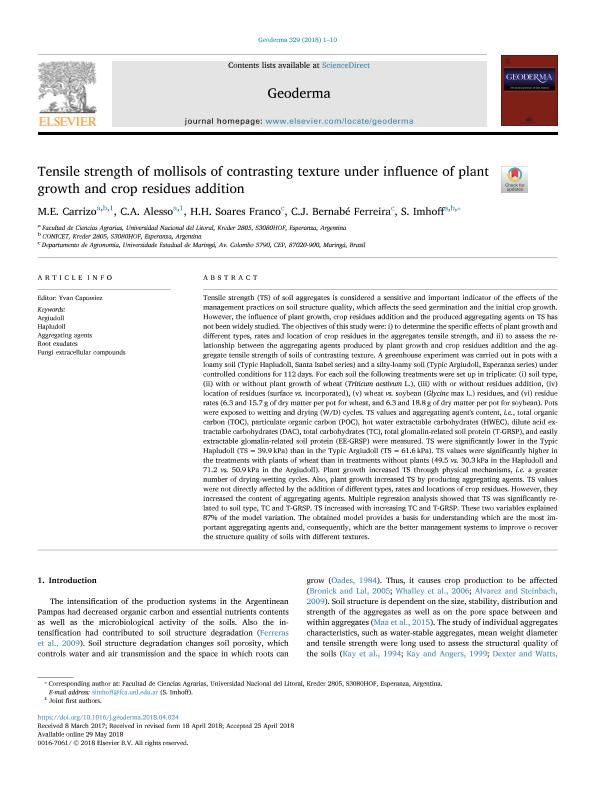Mostrar el registro sencillo del ítem
dc.contributor.author
Carrizo, Maria Eugenia

dc.contributor.author
Alesso, Carlos Agustín

dc.contributor.author
Soares Franco, H.H.
dc.contributor.author
Bernabé Ferreira, C.J.
dc.contributor.author
Imhoff, Silvia del Carmen

dc.date.available
2019-10-01T18:59:56Z
dc.date.issued
2018-11
dc.identifier.citation
Carrizo, Maria Eugenia; Alesso, Carlos Agustín; Soares Franco, H.H.; Bernabé Ferreira, C.J.; Imhoff, Silvia del Carmen; Tensile strength of mollisols of contrasting texture under influence of plant growth and crop residues addition; Elsevier Science; Geoderma; 329; 11-2018; 1-10
dc.identifier.issn
0016-7061
dc.identifier.uri
http://hdl.handle.net/11336/84960
dc.description.abstract
Tensile strength (TS) of soil aggregates is considered a sensitive and important indicator of the effects of the management practices on soil structure quality, which affects the seed germination and the initial crop growth. However, the influence of plant growth, crop residues addition and the produced aggregating agents on TS has not been widely studied. The objectives of this study were: i) to determine the specific effects of plant growth and different types, rates and location of crop residues in the aggregates tensile strength, and ii) to assess the relationship between the aggregating agents produced by plant growth and crop residues addition and the aggregate tensile strength of soils of contrasting texture. A greenhouse experiment was carried out in pots with a loamy soil (Typic Hapludoll, Santa Isabel series) and a silty-loamy soil (Typic Argiudoll, Esperanza series) under controlled conditions for 112 days. For each soil the following treatments were set up in triplicate: (i) soil type, (ii) with or without plant growth of wheat (Triticum aestivum L.), (iii) with or without residues addition, (iv) location of residues (surface vs. incorporated), (v) wheat vs. soybean (Glycine max L.) residues, and (vi) residue rates (6.3 and 15.7 g of dry matter per pot for wheat, and 6.3 and 18.8 g of dry matter per pot for soybean). Pots were exposed to wetting and drying (W/D) cycles. TS values and aggregating agent's content, i.e., total organic carbon (TOC), particulate organic carbon (POC), hot water extractable carbohydrates (HWEC), dilute acid extractable carbohydrates (DAC), total carbohydrates (TC), total glomalin-related soil protein (T-GRSP), and easily extractable glomalin-related soil protein (EE-GRSP) were measured. TS were significantly lower in the Typic Hapludoll (TS = 39.9 kPa) than in the Typic Argiudoll (TS = 61.6 kPa). TS values were significantly higher in the treatments with plants of wheat than in treatments without plants (49.5 vs. 30.3 kPa in the Hapludoll and 71.2 vs. 50.9 kPa in the Argiudoll). Plant growth increased TS through physical mechanisms, i.e. a greater number of drying-wetting cycles. Also, plant growth increased TS by producing aggregating agents. TS values were not directly affected by the addition of different types, rates and locations of crop residues. However, they increased the content of aggregating agents. Multiple regression analysis showed that TS was significantly related to soil type, TC and T-GRSP. TS increased with increasing TC and T-GRSP. These two variables explained 87% of the model variation. The obtained model provides a basis for understanding which are the most important aggregating agents and, consequently, which are the better management systems to improve o recover the structure quality of soils with different textures.
dc.format
application/pdf
dc.language.iso
eng
dc.publisher
Elsevier Science

dc.rights
info:eu-repo/semantics/openAccess
dc.rights.uri
https://creativecommons.org/licenses/by-nc-sa/2.5/ar/
dc.subject
AGGREGATING AGENTS
dc.subject
ARGIUDOLL
dc.subject
FUNGI EXTRACELLULAR COMPOUNDS
dc.subject
HAPLUDOLL
dc.subject
ROOT EXUDATES
dc.subject.classification
Otras Ciencias Agrícolas

dc.subject.classification
Otras Ciencias Agrícolas

dc.subject.classification
CIENCIAS AGRÍCOLAS

dc.title
Tensile strength of mollisols of contrasting texture under influence of plant growth and crop residues addition
dc.type
info:eu-repo/semantics/article
dc.type
info:ar-repo/semantics/artículo
dc.type
info:eu-repo/semantics/publishedVersion
dc.date.updated
2019-09-27T14:57:08Z
dc.journal.volume
329
dc.journal.pagination
1-10
dc.journal.pais
Países Bajos

dc.journal.ciudad
Amsterdam
dc.description.fil
Fil: Carrizo, Maria Eugenia. Consejo Nacional de Investigaciones Científicas y Técnicas. Centro Científico Tecnológico Conicet - Santa Fe; Argentina. Universidad Nacional del Litoral. Facultad de Ciencias Agrarias; Argentina
dc.description.fil
Fil: Alesso, Carlos Agustín. Consejo Nacional de Investigaciones Científicas y Técnicas. Centro Científico Tecnológico Conicet - Santa Fe; Argentina. Universidad Nacional del Litoral. Facultad de Ciencias Agrarias; Argentina
dc.description.fil
Fil: Soares Franco, H.H.. Universidade Estadual de Maringá; Brasil
dc.description.fil
Fil: Bernabé Ferreira, C.J.. Universidade Estadual de Maringá; Brasil
dc.description.fil
Fil: Imhoff, Silvia del Carmen. Consejo Nacional de Investigaciones Científicas y Técnicas. Centro Científico Tecnológico Conicet - Santa Fe; Argentina. Universidad Nacional del Litoral. Facultad de Ciencias Agrarias; Argentina
dc.journal.title
Geoderma

dc.relation.alternativeid
info:eu-repo/semantics/altIdentifier/url/https://www.sciencedirect.com/science/article/pii/S0016706117303828
dc.relation.alternativeid
info:eu-repo/semantics/altIdentifier/doi/https://doi.org/10.1016/j.geoderma.2018.04.024
Archivos asociados
